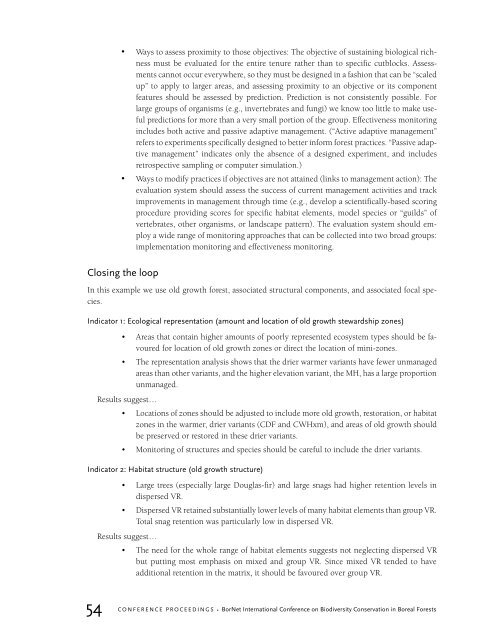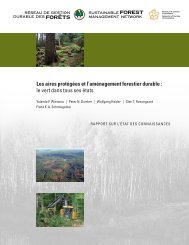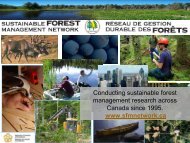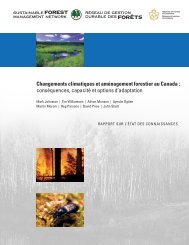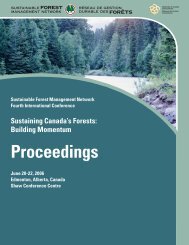Conference Proceedings - Sustainable Forest Management Network ...
Conference Proceedings - Sustainable Forest Management Network ...
Conference Proceedings - Sustainable Forest Management Network ...
You also want an ePaper? Increase the reach of your titles
YUMPU automatically turns print PDFs into web optimized ePapers that Google loves.
• Ways to assess proximity to those objectives: The objective of sustaining biological richness<br />
must be evaluated for the entire tenure rather than to specific cutblocks. Assessments<br />
cannot occur everywhere, so they must be designed in a fashion that can be “scaled<br />
up” to apply to larger areas, and assessing proximity to an objective or its component<br />
features should be assessed by prediction. Prediction is not consistently possible. For<br />
large groups of organisms (e.g., invertebrates and fungi) we know too little to make useful<br />
predictions for more than a very small portion of the group. Effectiveness monitoring<br />
includes both active and passive adaptive management. (“Active adaptive management”<br />
refers to experiments specifically designed to better inform forest practices. “Passive adaptive<br />
management” indicates only the absence of a designed experiment, and includes<br />
retrospective sampling or computer simulation.)<br />
• Ways to modify practices if objectives are not attained (links to management action): The<br />
evaluation system should assess the success of current management activities and track<br />
improvements in management through time (e.g., develop a scientifically-based scoring<br />
procedure providing scores for specific habitat elements, model species or “guilds” of<br />
vertebrates, other organisms, or landscape pattern). The evaluation system should employ<br />
a wide range of monitoring approaches that can be collected into two broad groups:<br />
implementation monitoring and effectiveness monitoring.<br />
Closing the loop<br />
In this example we use old growth forest, associated structural components, and associated focal species.<br />
Indicator 1: Ecological representation (amount and location of old growth stewardship zones)<br />
• Areas that contain higher amounts of poorly represented ecosystem types should be favoured<br />
for location of old growth zones or direct the location of mini-zones.<br />
• The representation analysis shows that the drier warmer variants have fewer unmanaged<br />
areas than other variants, and the higher elevation variant, the MH, has a large proportion<br />
unmanaged.<br />
Results suggest…<br />
• Locations of zones should be adjusted to include more old growth, restoration, or habitat<br />
zones in the warmer, drier variants (CDF and CWHxm), and areas of old growth should<br />
be preserved or restored in these drier variants.<br />
• Monitoring of structures and species should be careful to include the drier variants.<br />
Indicator 2: Habitat structure (old growth structure)<br />
• Large trees (especially large Douglas-fir) and large snags had higher retention levels in<br />
dispersed VR.<br />
• Dispersed VR retained substantially lower levels of many habitat elements than group VR.<br />
Total snag retention was particularly low in dispersed VR.<br />
Results suggest…<br />
• The need for the whole range of habitat elements suggests not neglecting dispersed VR<br />
but putting most emphasis on mixed and group VR. Since mixed VR tended to have<br />
additional retention in the matrix, it should be favoured over group VR.<br />
54<br />
CONFERENCE PROCEEDINGS • BorNet International <strong>Conference</strong> on Biodiversity Conservation in Boreal <strong>Forest</strong>s


